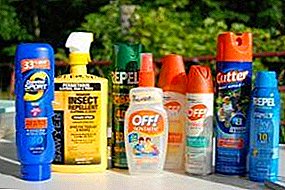 Cows on the farm, like other domestic animals, can suffer from various diseases.
Cows on the farm, like other domestic animals, can suffer from various diseases.
To control them, a veterinarian should be called, but a responsible farmer can always prevent the development of the disease on his own by taking certain preventive measures.
What is this disease
Telazioz is a common eye disease in cattle. In simple words, the cow's eyelids and cornea affect the helminthic pathogen, which in the worst case can permanently deprive the animal of sight.
Did you know? People domesticated cows more than 8 thousand years ago.
Causative agent
Roundworms of calves (small nematodes) cause telaziosis in cows. Like other parasites, they are divided into several dangerous species that are the main causative agents of the disease:
- Thelazia rhodesi - considered the most pathogenic form. Sizes: the length of the male is 10 mm, the width is 0.45 mm, the female can reach 21 mm in length and 0.50 in width. Body color varies from yellow to brown, the cuticle is transversely striated and slightly serrated. The larvae are 0.49 mm long, have a spherical cap and beveled head end without bulges.
- Thelazia gulosa - the parasite is equipped with a large oral capsule resembling a bowl. The size of the male is 9.1 mm long, 0.53 mm wide. The female is 16 mm in length, 0.60 mm in width.
- Thelazia skrjabini - differs from other species by a small oral capsule and short spicules. The transverse striation of the cuticle is completely absent. The length of the male is 9 mm, the females 19 mm.
 The telazioz cows can cause any of these worms, in the most advanced cases in the conjunctival sac several groups can multiply at once.
The telazioz cows can cause any of these worms, in the most advanced cases in the conjunctival sac several groups can multiply at once.
For parasitic diseases of cattle also include cysticercosis.
Helminth development cycle
Infection with teliasis occurs after the attack of the infested flies on the moist skin of the inner corner of the eye or eyelid of the cow. Invasive larvae of teliasias fly through the proboscis of the fly initially on the skin, then on the eyes, where they develop to maturity. The process takes about 3-6 weeks. The life span of nematodes is a year. In the cow's eyes, they calmly survive the winter period.
Detailed development scheme for calves: 
Sources of infection
Infection of livestock occurs in various pastures, in rare cases - in barns. The flight of cow flies begins as early as May and lasts until the autumn, just in the warm season of cow walking.
Common diseases of cows are: ketosis, leukemia, foot and mouth disease, ringworm.
Symptoms
An infected cow has 3 stages of painful development, which manifest themselves through certain clinical symptoms:
- Stage 1 - acute conjunctivitis manifests itself; slight damages can be noted on the cornea of the eye, the animal avoids light in every way, its eyes are very watery;
- Stage 2 - after a few days from the affected eyes, along with mucus, pus begins to emit (serous-mucous fluid); on the eyelids you can notice a strong redness and swelling, sometimes the cow is not able to even open his eyes;
- Stage 3 - sores appear on the cornea, it becomes cloudy, and then reddens; the eye vessels are very bloodshot, the vision is greatly reduced, the cow cannot open the eyes; general intoxication of the organism is manifested - the cow becomes apathetic, completely loses its appetite and productivity; there is an increase in body temperature of 1-2 ° C.

Diagnostics
The diagnosis occurs after veterinary history taking and on the basis of epizootological data, detection of clinical signs, as well as the results of laboratory tests (larvoscopy of lacrimal fluid or flushing of the conjunctiva of the eye).
Important! The specialist must also necessarily differentiate between fever and infectious rhinotracheitis, herpes virus infection, rickettsial keratoconjunctivitis, hypovitaminosis A, as well as non-contagious conjunctivitis.
Pathological changes
The disease is characterized by:
- the presence of conjunctivitis, keratitis;
- damage to the lens;
- clouding of the cornea, the appearance of ulcers on it.
 Purulent conjunctivitis in cattle
Purulent conjunctivitis in cattle
Treatment of sick cattle
Depending on the severity of the course of the veterinary patient, the veterinarian prescribes a specific treatment regimen, including antibacterial and anthelmintic drugs of a broad spectrum of action, homeopathy, immune modulators, therapeutic drops or ointments.
Antibiotics
Good results in the treatment of fever are shown by macrolide antibiotics, which should be placed daily in the cavity of the conjunctival sac once, within 5 days. The most common of these is Azithromycin. Dosage for cattle - 0.9-1.1 g.
Important! At the first manifestations of fever, you should immediately contact the veterinarian, not waiting for the development of further stages.
Anthelmintic and antiparasitic drugs
For the complete eradication of the disease and the prevention of the development of helminths in the rest of the population, antiparasitic therapy is carried out to the entire population.  Effective drugs and dosage:
Effective drugs and dosage:
- Ivomek - administered once, 1 ml of the drug per 50 kg of the individual;
- Levamisole - once, 0,0075 g per 1 kg;
- Rivertin - 2 days, 0.2 g per 1 kg;
- Fascoverm - once, 0,005 g per 1 kg;
- The solution ditrazina-citrate (25%) is injected subcutaneously, twice with an interval after 24 hours. Dosage - 0,016 g per 1 kg of mass.
In order to understand how productive a cattle herd is, it is necessary to carry out a livestock assessment.
Drops, ointment
An important role in the speedy recovery is played by additional washings with special solutions and drops:

- A solution of iodine with potassium iodide. Method of preparation: Dilute 1 g of crystalline iodine and 1.5 g of potassium iodide in two liters of purified water. Washing the affected eye is done three times a day with a rubber tip syringe. The flow rate for each wash is about 75 ml.
- Boric acid solution (3%). The walls of the eye cavity and the area of the inner corner of the eye are wiped with moistened cotton swabs. Manipulation is repeated 3 times a day, for 5-7 days.
- Antibacterial Penicillin Drops on 50 thousand units, are applied according to the recipe of the veterinarian.
- Novocaino-penicillin ointment used in the presence of ulcers on the eye cornea. Before use, the agent must be kept for 5-7 days at a temperature of + 2-4 ° C.
- Chamomile, calendula, marsh wild rosemary infusions (in the ratio 1: 100).
Prevention of cow calves
In warm regions, where outbreaks of telaesiosis occur annually (Bashkortostan, Ukraine, southern Russia), at the end of the stall period and spring, farmers produce planned anthelmintic treatment of the entire herd. For prevention, as a rule, a water-iodine solution is used.
Find out what determines the weight of cattle and how much an average bull weighs, a cow, a calf.
Another measure is the extermination of pasture flies (spreaders of infection). To do this, apply 0.1% ectomine, which is sprayed on animals before going out to pasture.  A few more important recommendations:
A few more important recommendations:
- the hay that feeds the cows should be as clean as possible from the dung;
- periodic pasture change will reduce the risk of worming;
- calves should be grazed separately from adults;
- Do not graze cows nearby with sheep, the latter are most often infected with tapeworms;
- avoid situations in which the cow will drink from a swamp or puddle;
- it is necessary to keep livestock only in clean barns.
Did you know? Cows were not always ruminant animals, they gradually had to change in the course of evolution. Since the cows could not run very fast, they did not have fangs and claws, a special way to digest food appeared: they quickly grabbed it, swallowed it without chewing, ran away, and then they had to doze it - in complete peace of mind.With the observance of prophylactic rules, domestic livestock can be easily protected from fever and other diseases. However, at the slightest suspicion of helminth eye damage, you should as soon as possible contact a specialist and begin a comprehensive treatment.












